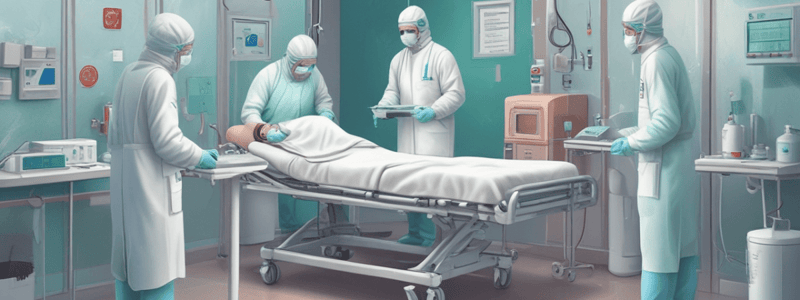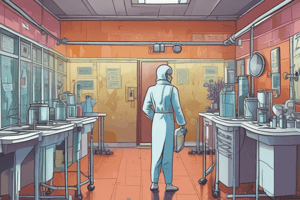Podcast
Questions and Answers
What is the primary purpose of applying aseptic/clean technique?
What is the primary purpose of applying aseptic/clean technique?
- To handle sharps safely
- To prevent airborne transmission of infections
- To prevent droplet transmission of infections
- Prior to invasive procedures, or medication administration (correct)
When should hospital-grade disinfectant be used?
When should hospital-grade disinfectant be used?
- Only for contact precaution patients
- Only for invasive procedures
- Only for airborne precaution patients
- Following every patient care event (correct)
What should be done with stretcher linen after every patient care event?
What should be done with stretcher linen after every patient care event?
- Change (correct)
- Leave as is
- Clean and disinfect
- Dispose of
What should be included in pre-arrival communication and documentation?
What should be included in pre-arrival communication and documentation?
When should PPE be removed?
When should PPE be removed?
What should be used for airborne precaution patients?
What should be used for airborne precaution patients?
What is the purpose of Modified Respiratory precautions?
What is the purpose of Modified Respiratory precautions?
What is the proper way to handle sharps?
What is the proper way to handle sharps?
What is the primary goal of infection prevention and control (IP&C) in healthcare settings?
What is the primary goal of infection prevention and control (IP&C) in healthcare settings?
What is the single most effective infection prevention and control procedure to control infections in the workplace and reduce the spread of infections?
What is the single most effective infection prevention and control procedure to control infections in the workplace and reduce the spread of infections?
When is it necessary to perform an Infection Prevention and Control Risk Assessment (IPC-RA)?
When is it necessary to perform an Infection Prevention and Control Risk Assessment (IPC-RA)?
What is the purpose of an Infection Prevention and Control Risk Assessment (IPC-RA)?
What is the purpose of an Infection Prevention and Control Risk Assessment (IPC-RA)?
What is the correct sequence of hand hygiene (HH) practices?
What is the correct sequence of hand hygiene (HH) practices?
When is it necessary to use personal protective equipment (PPE)?
When is it necessary to use personal protective equipment (PPE)?
What is the purpose of gloves in infection prevention and control?
What is the purpose of gloves in infection prevention and control?
What is the relationship between routine practices and additional precautions in infection prevention and control?
What is the relationship between routine practices and additional precautions in infection prevention and control?
Study Notes
Infection Prevention and Control (IP&C)
- The main goal of IP&C is to prevent the transmission of health-care-associated infections to patients and EMS practitioners.
Routine Practices
- Routine practices do not include the use of personal protective equipment (PPE).
- Hand hygiene (HH) is the single most effective IP&C procedure to control infections in the workplace and reduce the spread of infections.
Infection Prevention and Control Risk Assessment (IPC-RA)
- Perform an IPC-RA for any of the following:
- Presence of blood or body fluid
- Assess for signs and symptoms of infections (respiratory tract infection, gastrointestinal tract infection, septic shock, specific site infections)
- Performing an aerosol generating medical procedure
Hand Hygiene (HH)
- Perform HH:
- Before entering or touching a patient or their environment (except during emergent events)
- Before any aseptic procedure
- After exposure to body fluids
- After leaving the patient or their environment
Personal Protective Equipment (PPE) and Isolation Procedures
- PPE is used only if IPC-RA indicates (Additional Precautions)
- Types of isolation procedures and corresponding PPE:
- Contact precautions (e.g., antibiotic resistant organisms)
- Hand hygiene, gown, and gloves
- Contact and Droplet precautions (e.g., respiratory infections, sepsis, diarrheal or vomiting patients)
- Hand hygiene, gown, simple mask, safety glasses/face shield, and gloves
- Modified Respiratory precautions (e.g., respiratory symptoms and aerosol-generating medical procedures)
- Hand hygiene, gown, N-95 respirator, safety glasses/face shield, and gloves
- Droplet precautions (e.g., mumps, pertussis)
- Hand hygiene, gown, simple mask, safety glasses/face shield, and gloves
- Airborne precautions (e.g., tuberculosis, measles)
- Hand hygiene, N-95 respirator
- Airborne and Contact precautions (e.g., chicken pox, disseminated shingles)
- Hand hygiene, N-95 respirator, gown, gloves
- Contact precautions (e.g., antibiotic resistant organisms)
Additional Precautions and Guidelines
- Aseptic/clean technique:
- Applied prior to invasive procedures, or medication administration
- Sharps handling:
- Activate safety engineered device
- Dispose of at point of care
- PPE removal:
- Remove before entering the healthcare facility unless there is a continued risk of exposure
- Cleaning and disinfection:
- Must be performed following every patient care event
- Hospital-grade disinfectant requires firm pressure and adequate wet time to remove pathogens
- Stretcher linen:
- Must be changed following every patient care event
- Pre-arrival communication and documentation:
- Alert receiving facility if the patient is suspected to have an infection risk in the IPC-RA
- Document level of Additional Precautions, PPE use, and exposure, if applicable
Studying That Suits You
Use AI to generate personalized quizzes and flashcards to suit your learning preferences.
Description
This quiz assesses knowledge of infection prevention and control practices in healthcare settings, including routine practices and additional precautions. It covers the importance of risk assessment and personal protective equipment in preventing healthcare-associated infections.




